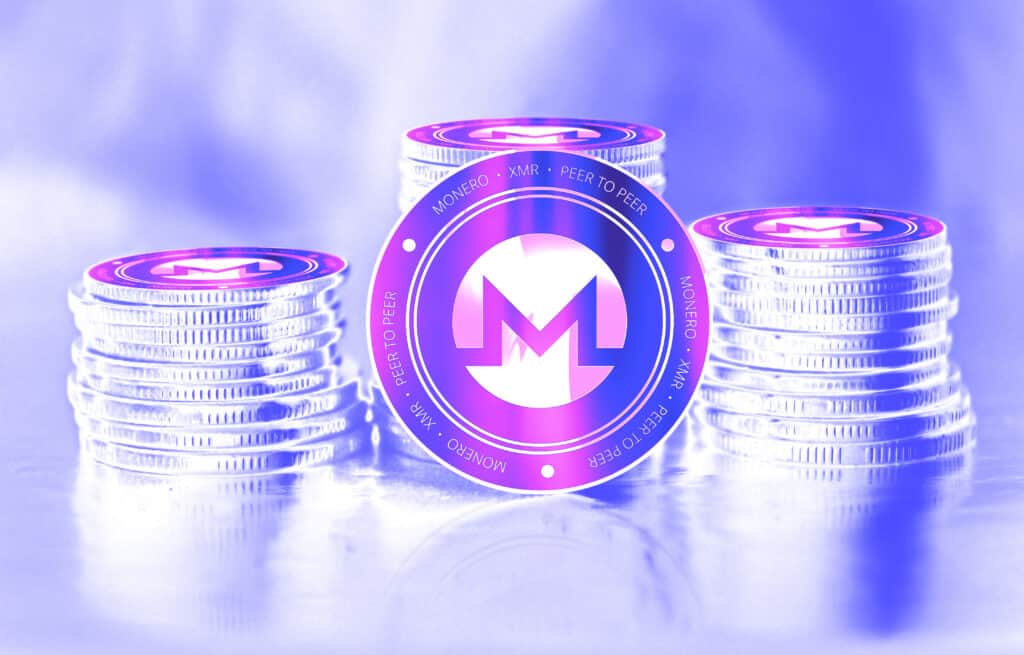Disclaimer: This is not a validation of cryptocurrency or any particular provider, service, or product. It should not be taken as advice to engage in trading or use any services.
Please check our terms and conditions.
Quick Answer:
The Monero blockchain is stored on each node participating in the Monero network. When a user runs a full Monero node, the blockchain is downloaded and stored locally on the user’s computer or device.
This decentralized storage ensures that the network remains secure and allows for verification of transactions without relying on a central authority. The size of the blockchain grows with the addition of new transactions, so the storage space required can increase over time.
Cryptocurrencies offer users a wide variety of services and use-cases, but privacy remains a huge concern because of the vast range of cyber security issues and risks on the internet. This is why privacy-focused digital currencies were invented, to help users protect their personal information and conduct blockchain transactions without compromising their anonymity.
Digital currencies such as Zcash (ZEC), DASH, and Monero (XMR) are some of the most popular examples of cryptos that are focused on providing users with a means for secure and fully private transactions of funds with the help of blockchain technology.
So far, Monero is the most successful privacy-oriented crypto on the market, with its technological solutions that provide users with full anonymity while transferring funds and facilitating payments.
Let’s take a detailed look at Monero, how it works, and where the XMR blockchain is stored on your device should you choose to keep a copy of it.

What Is Monero (XMR) and How Does It Work?
Just like Bitcoin, Monero is a cryptocurrency primarily developed to be used as decentralized digital cash. Monero isn’t a crypto like Ethereum (ETH), Polkadot (DOT), or Solana (SOL) which are focused on smart contract functionalities and decentralized apps. It’s simply a crypto made for facilitating payments and transactions in a secure manner, without letting any third party reveal your personal information.
Monero transactions let users transfer funds while staying totally anonymous, which is something only a handful of cryptos can offer.
Both the sender and receiver of XMR coins as well as the transferred amount of Monero stay undisclosed to everyone except the involved parties.

Monero History
The project that inspired the creation of Monero was called Bytecoin. It was the first cryptocurrency that used CryptoNote technology when it was launched in 2012. This technology guarantees user privacy by grouping together public keys and including multiple keys in every transaction. This makes it impossible to isolate the real key because the fake ones obscure it.
These ring signatures were the key aspect of CryptoNote technology which was later used by Monero developers when they launched the project in 2014.
The technology behind Monero is open-source and various developer teams have later used the Monero code for creating their versions of privacy-focused cryptos.
Monero Privacy Technology
The innovative concept of providing users with full privacy when sending and receiving funds is what XMR is all about. It’s impossible for third parties to connect a Monero transaction with your identity unless you leave information that connects your ID and your Monero wallet address somewhere online.
As long as you use your XMR wallet address for transactions and don’t disclose your ownership of the address to anyone or anywhere, you are totally secure.
Ring Confidential Transactions are an important feature of the Monero blockchain because they ensure that even the amount of transferred funds stays private, thanks to the network’s advanced cryptography.
Monero’s privacy level is something that is constantly improved by the developer team behind the currency and there is a very active developer community called Monero Research Lab (MRL), tasked with monitoring potential bugs and finding ways to further improve the network.
Also, XMR has a very well-developed educational platform called Moneropedia, where all aspects of the currency are explained in detail, along with videos that showcase all of the features that make Monero so safe and secure.
XMR Fungibility
Unlike Bitcoin, Ethereum, and other popular cryptos with public ledgers of transactions, the Monero blockchain is fully fungible and absolutely all coins appear the same on the network. With BTC, ETH, and other non-privacy-focused currencies that have a public ledger, anyone can search their blockchain with the help of a block explorer platform and see the exact addresses from which certain coins originate and view their transaction history.
This means that in case some BTC is used for some illegal activity and then ends up as payment for a vendor, that vendor might later have problems when they want to exchange those coins on an exchange platform that checks the origin of coins. Also, some exchange platforms don’t accept coins that come from gambling, which isn’t even illegal activity.
Thanks to Monero’s advanced encryption technology, XMR coins are totally untraceable and no one can see any difference between individual coins because their origin is obscured and their transaction history is non-existent. The Monero blockchain doesn’t keep a transfer history, making all XMR coins fungible.
Scalability
For many cryptocurrencies, scalability is a huge issue, especially when their community starts rapidly growing and attracting new users to the ecosystem.
For example, as BTC started growing in popularity and value, the Bitcoin blockchain started getting really busy and because each block is limited to just 1MB of transaction data, periods of high network congestion became common. During periods of high network busyness, the transactions with higher transfer fees are always the ones that get processed faster because miners select them before the transfer with lower fees.
With Monero, this scalability issue and network congestion problem is resolved practically because there is no predefined block size. Instead, each new block takes the median size of the previous 100 blocks as a measure for the new block’s size.
Thus, miners create each new block according to these measures and the block reward is fixed at 0.3 XMR per block. The reward will always stay the same and mining Monero won’t get progressively more difficult like in the case of BTC.
Multiple Key Technology
Most cryptocurrencies use the classic public key and private key model, where a public key is the blockchain address to where you can accept and store a cryptocurrency, while the private key acts as a password that proves your ownership over a certain amount of that currency.
Monero uses a different, multi-key approach. There are public and private spend keys, along with a public view key and a private view key.
Every outgoing transfer of XMR is created by private spend keys, while a public spend key is used to verify the signature on each transaction. For each stealth public address, a public view key is generated and in order to check the Monero blockchain for a specific transaction, you need the appropriate private view key for that transfer.

Monero Wallets
There are two types of Monero wallets that are developed by the Monero community and developers. The first type is the Monero CLI (command line interface) wallet which is mostly used by more advanced, experienced Monero users with some programming knowledge. This wallet enables users to use their own copy of the XMR blockchain or a version that’s publicly available.
For an additional layer of privacy, users can facilitate transactions through the TOR browser with this wallet and they can use a remote XMR node while downloading the whole blockchain to their device.
Also, users can choose to download only ⅓ of the blockchain and browse it if they don’t have enough disk space on their computer. The wallet is compatible with Trezor and Ledger Nano hardware wallets.
The second more commercial wallet is the Monero GUI (graphical user interface) wallet, which is more suitable for beginners and average crypto users that want a simple, user-friendly experience when transferring and storing Monero.
The GUI wallet has most of the functions of the CLI version and it also includes some practical options such as in-app fiat conversion to see how much is your XMR currently worth in USD. It also allows you to easily switch between Simple and Advanced wallet mode.
Both wallets are available on getmonero.org.

Storing Monero Blockchain on Your Computer
When downloading the Monero blockchain on a PC or laptop computer, users quite often can’t find the blockchain data files and sometimes they think it’s some sort of bug or mistake. Actually, because Monero is such a secure and privacy-focused cryptocurrency, the developers made sure that when you download the blockchain for use with your Monero wallet, the blockchain files stay hidden on your hard drive. This is just an extra precautionary measure in case your computer gets compromised.
On a computer with a Windows operating system, the default installation directory for the XMR blockchain should be C:ProgramDatabitmonerolmdb.
This is a hidden folder that won’t just appear when searching manually through your files – you’ll need administrator permission to view the contents. It’s a quite nice additional security feature.
The folder should be similar for Linux and MAC OS computers and the easiest way to find the folder is by pasting the listed directory path into your Windows Explorer, Linux Explorer, or MAC Finder.
A Few Final Words…
If you’re looking for a cryptocurrency that works great as digital cash and takes care of your privacy without disclosing any information to third parties no matter what, then Monero is a perfect choice for you.
The fact that the XMR community is constantly looking for ways to improve the Monero network is an especially great characteristic of Monero, which provides safety from cyber attacks and any unwanted attention.
About The Author

James Page, previously the lead writer at Crypto Head and a registered psychologist, brings a unique perspective to the world of blockchain and cryptocurrency.
His extensive experience in the industry and ability to present complex concepts in an understandable manner make his articles a valuable resource for readers seeking to navigate the ever-evolving crypto landscape.
Check James out on:
This article was originally published by a cryptohead.io . Read the Original article here. .

